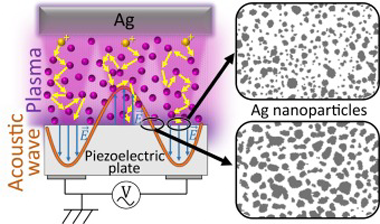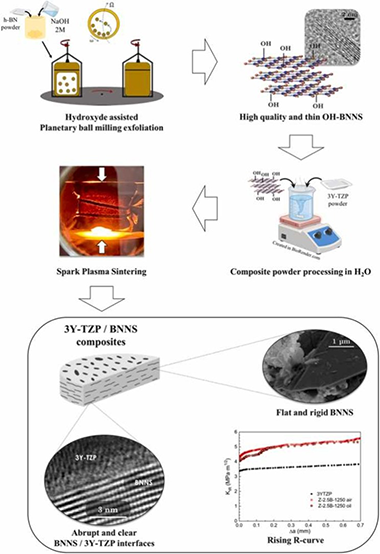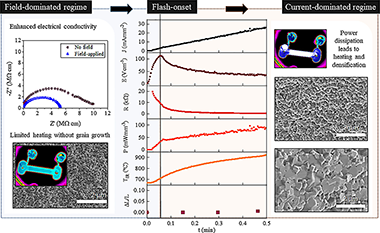Artículos SCI
2024
2024
Nanotecnología en Superficies y Plasma
Nucleation and growth of plasma sputtered silver nanoparticles under acoustic wave activation
Reichel, H; García-Valenzuela, A; Espino-Román, JA; Gil-Rostra, J; Regodón, GF; Rico-Gavira, V; Borrás, A; Gómez-Ramírez, A; Palmero, A; González-Elipe, AR; Oliva-Ramírez, MApplied Surface Science, 669 (2024) 160566
Show abstract ▽

Early results on the plasma deposition of dielectric thin films on acoustic wave (AW) activated substrates revealed a densification pattern arisen from the focusing of plasma ions and their impact on specific areas of the piezoelectric substrate. Herein, we extend this methodology to tailor the plasma deposition of metals onto AW-activated LiNbO3 piezoelectric substrates. Our investigation reveals the tracking of the initial stages of nanoparticle (NP) formation and growth during the submonolayer deposition of silver. We elucidate the specific role of AW activation in reducing particle size, enhancing particle circularity, and retarding NP agglomeration and account for the physical phenomena making these processes differ from those occurring on non-activated substrates. We provide a comparative analysis of the results obtained under two representative plasma conditions: diode DC sputtering and magnetron sputtering. In the latter case, the AW activation gives rise to a 2D pattern of domains with different amounts of silver and a distinct size and circularity for the silver NPs. This difference was attributed to the specific characteristics of the plasma sheath formed onto the substrate in each case. The possibilities of tuning the plasmon resonance absorption of silver NPs by AW activation of the sputtering deposition process are discussed.
Octubre, 2024 | DOI: 10.1016/j.apsusc.2024.160566
Materiales y Procesos Catalíticos de Interés Ambiental y Energético
In situ XRD and operando XRD-XANES study of the regeneration of LaCo0.8Cu0.2O3 perovskite for preferential oxidation of CO
Pereñiguez, RP; Ferri, DMaterials Today Sustainability, 27 (2024) 100867
Show abstract ▽
Combinations of perovskite-type oxides with transition and precious metals exhibit remarkable regenerating properties that can be exploited for catalytic applications. The objective of the present work was to study the structural changes experienced by LaCo0.8Cu0.2O3 under reducing/oxidizing atmosphere (redox) and Preferential Oxidation of CO (PrOx, with high H2 concentration) conditions and their reversibility. LaCo0.8Cu0.2O3 was prepared by ultrasonic spray combustion and was characterized by X-ray diffraction (XRD) and X-ray absorption spectroscopy (XAS). Structural changes were followed by operando XRD and XAS. Metallic Co and Cu were segregated under both sets of reducing conditions and re-dissolved into the perovskite upon oxidation at 500 °C. Simultaneously, the perovskite-type oxide disappeared under reducing conditions and formed again upon high-temperature oxidation. The effects of this reversible reduction/dissolution of B-site metals on catalyst structure and activity were studied concerning the catalytic process of PrOx. The active phases of cobalt and copper oxides suffer a reduction during the PrOx reaction due to the high H2 concentration; thus, the application of an intermediate oxidation treatment can regenerate the catalytic system and the perovskite can be used for several cycles of reaction and regeneration. In contrast, when this intermediate oxidation treatment is not applied, the catalytic performance decreases in successive activity cycles.
Septiembre, 2024 | DOI: 10.1016/j.mtsust.2024.100867
Reactividad de Sólidos - Tribología y Protección de Superficies
BN nanosheets reinforced zirconia composites: An in-depth microstructural and mechanical study
Muñoz-Ferreiro, C; Reveron, H; Rojas, TC; Reyes, DF; Cottrino, S; Moreno, P; Prada-Rodrigo, J; Morales-Rodriguez, A; Chevalier, J; Gallardo-López, A; Poyacto, RJournal of the European Ceramic Society, 44(10) (2024) 5846-5860
Show abstract ▽

This paper deals with the effect of hydroxylated boron nitride nanosheets (BNNS) incorporation on the microstructural and mechanical features of zirconia ceramics. Few-layered BNNS were synthesized via a simple hydroxide-assisted planetary ball milling exfoliation technique. 3 mol% yttria tetragonal zirconia polycrystal (3Y-TZP) with 2.5 vol% BNNS powders were prepared by an environmentally friendly process in water, and spark-plasma sintered at three temperatures to explore the in-situ reduction of the functionalized BNNS. An exhaustive study by (S)TEM techniques was performed to elucidate the influence of the sintering temperature on the matrix and the 3Y-TZP/BNNS interfaces, revealing that BNNS were homogeneously distributed throughout the matrix with an abrupt transition at 3Y-TZP/BNNS interfaces. BNNS effectively hindered slow crack growth, thus increasing the composite's crack growth resistance by about 30 %. A 1 MPa·m1/2 rising R-curve was also induced by crack bridging.
Agosto, 2024 | DOI: 10.1016/j.jeurceramsoc.2024.02.002
Materiales Semiconductores para la Sostenibilidad
Strong angular and spectral narrowing ofelectroluminescence in an integrated Tamm-plasmon-driven halide perovskite LED
Ying, Z; Jiménez-Solano, A; Gatkowski, K; Sun, Y; Ferrer Orri, J; Frohna, K; Salway, H; Kahmann, S; Nie, S; Vega, G; Kar, S; Novak, MP; Máckowski, S; Nyga, P; Ducati, C; Greenham, NC; Lotsch, BV; Anaya, M; Stranks, SDNature Commications, 15 (2024) 5802
Show abstract ▽
Next-generation light-emitting applications such as displays and opticalcommunications require judicious control over emitted light, includingintensity and angular dispersion. To date, this remains a challenge as con-ventional methods require cumbersome optics. Here, we report highly direc-tional and enhanced electroluminescence from a solution-processed quasi-2-dimensional halide perovskite light-emitting diode by building a devicearchitecture to exploit hybrid plasmonic-photonic Tamm plasmon modes. Byexploiting the processing and bandgap tunability of the halide perovskitedevice layers, we construct the device stack to optimise both optical andcharge-injection properties, leading to narrow forward electroluminescencewith an angular full-width half-maximum of 36.6° compared with the con-ventional isotropic control device of 143.9°, and narrow electroluminescencespectral full-width half-maximum of 12.1 nm. The device design is versatile andtunable to work with emission lines covering the visible spectrum with desireddirectionality, thus providing a promising route to modular, inexpensive, anddirectional operating light-emitting devices.
Julio, 2024 | DOI: 10.1038/s41467-024-49838-1
Reactividad de Sólidos
On the athermal origin of flash sintering: Separating field-induced effects from Joule heating using a current ramp approach
Molina-Molina, S; Perejón, A; Pérez-Maqueda, LA; Sánchez-Jiménez, PEScripta Materialia, 247 (2024) 116086
Show abstract ▽

Joule heating is generally acknowledged as the main driving force behind Flash Sintering. However, this view is challenged by the presence of athermal phenomena and the similarities between the flash process and dielectric breakdown. This work offers new insights into flash as an electrical runaway. Using current ramps to perform flash experiments on zinc oxide, two distinct stages within the process were revealed by electrical, thermal and microstructural measurements: a field-dominated regime where the flash event is triggered and a subsequent current-dominated regime associated with power dissipation. The contribution of each regime to the whole flash process was found to be determined by the initial resistivity of the sample. Furthermore, impedance spectroscopy data confirmed field-induced enhancement of conductivity at the flash-onset without significant Joule heating.
Julio, 2024 | DOI: 10.1016/j.scriptamat.2024.116086
- 1 of 419
- siguiente ›














